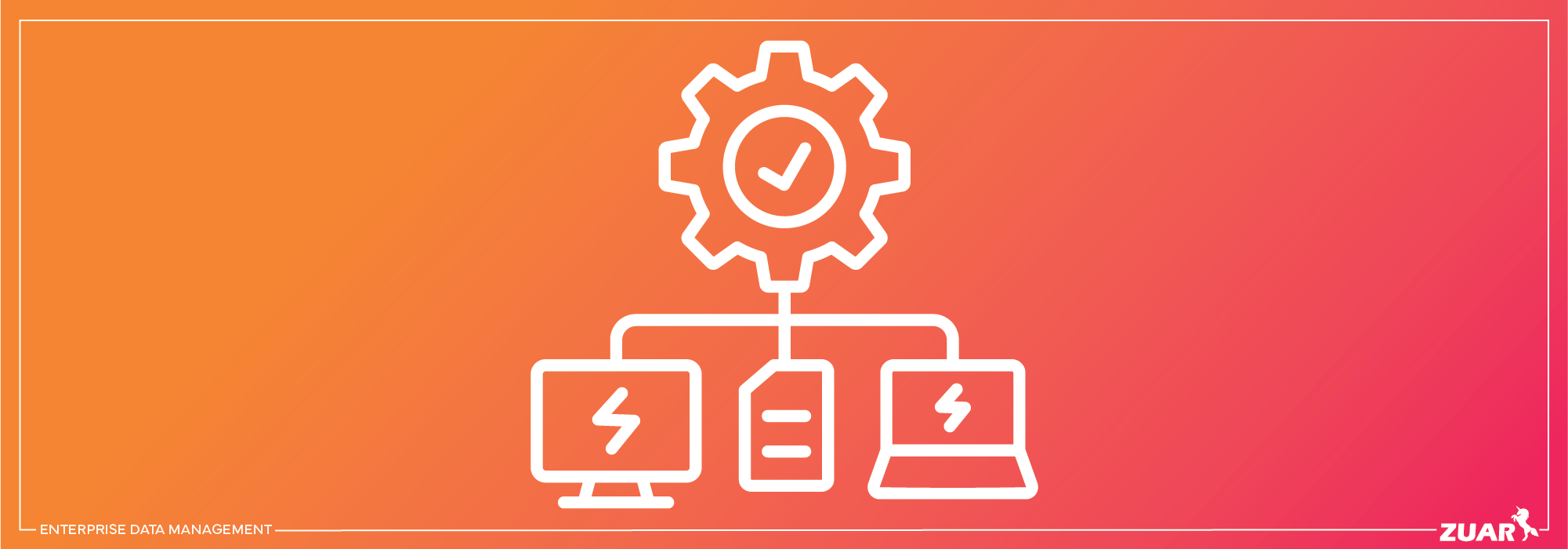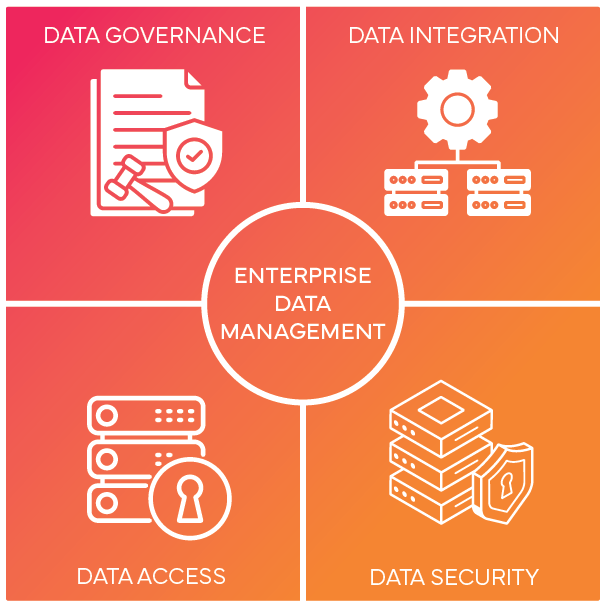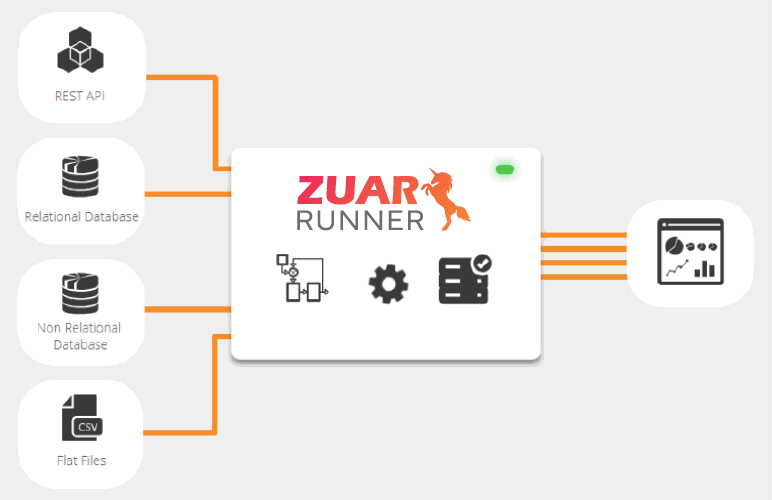Enterprise Data Management: What It Is & How To Succeed At It
Learn what Enterprise Data Management is, including its key components, how it differs from Master Data Management, its challenges, and more!

Overview
In 2023, the importance of effective Enterprise Data Management (EDM) cannot be overstated. As organizations continue to generate and rely on vast amounts of data, harnessing the power of that data is vital to operational efficiency, decision-making, and ultimately, success.
But what does it take to truly unlock the benefits of EDM? What are the key components and strategies that can transform the way an organization manages its data assets?
In this article, we will delve into the world of EDM, exploring its core components, the role of Master Data Management (MDM), and the advantages of adopting EDM solutions.
We will also discuss the challenges organizations face in implementing EDM strategies, the emerging trends and technologies shaping the future of data management, and real-world success stories of companies leveraging EDM to drive revenue.
Key Takeaways
- Unlock the benefits of Enterprise Data Management (EDM) by focusing on data governance, integration, access, and security.
- Master Data Management (MDM) plays a critical role in facilitating an effective EDM strategy for organizations.
- Adopting EDM solutions can help reduce expenses and improve customer experience and operational efficiency while overcoming challenges with technology and organizational commitment to best practices.

Understanding Enterprise Data Management (EDM)
Enterprise Data Management (EDM) is a strategic process that organizes, governs, and maintains an organization’s data assets. It utilizes policies and technologies to maintain:
- Data accuracy
- Data completeness
- Data reliability
- Data quality
- Data accessibility
- Data usability
For any organization aiming to utilize data for informed business decisions, operational efficiency, and business success, EDM becomes indispensable.
Ensuring data reliability is crucial, as inaccurate data can lead to damage to an organization’s reputation and even potential regulatory repercussions. As a result, proper data management is no longer just a nice-to-have – it’s a necessity for organizations in today’s data-driven world.
How Does EDM Differ From Data Management?
The key difference between data management and enterprise data management (EDM) lies in their scope and strategic focus.
Data management encompasses the general practices and processes for handling data within an organization, covering various data types and may be department-specific.
In contrast, EDM is a holistic, organization-wide strategy that aligns data management practices with broader business objectives. Essentially, EDM is a more comprehensive and strategic approach, while data management can be more localized and tactical in nature.

Key Components of Effective Enterprise Data Management
Unlocking the full potential of enterprise data requires organizations to concentrate on four key components:
- Data governance
- Data integration
- Data access
- Data security
These are four pillars of proper data management that guarantee the availability of quality data for informed decision-making and regulatory compliance.

Data Governance
Data governance involves establishing policies, procedures, and standards to manage data throughout its lifecycle. The purpose of data governance is to ensure:
- The availability, usability, integrity, and security of data in enterprise systems
- Data accuracy
- Enhanced data quality
- Reduced data management costs
Implementing robust data governance practices enables organizations to achieve these goals.
However, implementing data governance can prove to be a complex process, requiring organizational acceptance and regular maintenance. Despite these challenges, the benefits of effective data governance far outweigh the obstacles, making it a critical component of a successful EDM strategy.
Data Integration
Data integration is the process of consolidating data from multiple sources into a unified, consistent format for analysis and decision-making.
This component of EDM allows organizations to integrate data and analyze it from multiple sources, facilitating informed decisions and providing insight into operations.
Additionally, data integration serves to reduce costs and improve efficiency by eliminating the requirement to manually transfer data between systems.
Data integration can be challenging and labor-intensive, as it necessitates the integration of various systems and data formats. Moreover, data security and privacy considerations must be taken into account when integrating data from multiple sources.
As organizations progress through digital transformation, data integration solutions will become more advanced and automated, permitting organizations to rapidly and securely access and analyze data from multiple sources.
An example of such an integration platform is Zuar's ELT solution Zuar Runner. This BI solution automates the collection of data from hundreds of potential sources and transport it to a single, centralized destination.

Data Access
Data access refers to the capability of retrieving, modifying, copying, and moving data from IT systems.
Data access is imperative for organizations to make informed decisions and optimize their operations, enabling authorized users to access the data they need promptly and securely, while also guaranteeing that data privacy and security are maintained.
However, data access can be complex due to the intricacies of the data and the necessity to guarantee data privacy and security.
Additionally, organizations must verify that the data is precise and up-to-date, and that the data access process is efficient and secure. Overcoming these challenges requires a strong commitment to data management best practices and the right technology to ensure data access is both seamless and secure.
Utilizing an embedded analytics solution such as Zuar Portal is an effective way of controlling data access. Zuar Portal allows you to create unique analytics hubs that can be securely shared with all relevant stakeholders.

Data Security
Data security entails safeguarding data from unauthorized access, corruption, or loss and aids in guaranteeing the accuracy of data and averting data breaches. To ensure data security, organizations can implement measures such as:
- Encryption
- Authentication
- Access control
- Data backup
- Data monitoring
Data security challenges include the expense of implementation, the intricacy of managing data security, and the requirement for continual maintenance.
Despite these challenges, investing in robust data security measures is crucial for ensuring the integrity and privacy of an organization’s data assets – a key component of effective EDM.

The Role of Master Data Management in EDM
Master Data Management (MDM) is a subset of EDM that focuses on creating a single, consistent view of data across the organization. MDM helps organizations establish and manage processes that enable them to become a digital product delivery service.
A master file in MDM contains all necessary dimensions within the dataset, presented in a standardized format, such as vendors in a supply chain, their location, and reference data.
MDM concentrates on establishing a unified, consistent view of data throughout the organization, facilitating a more streamlined data management approach.
This, in turn, contributes to the overall effectiveness of an organization’s EDM strategy, ensuring that the right data is available to the right people at the right time.

Implementing an Enterprise Data Management Strategy
The initial step in executing an EDM strategy is to evaluate existing data systems to comprehend data flows and processes.
By understanding the current state of data management within the organization, it becomes easier to identify areas for improvement and to develop a comprehensive plan for implementing best practices such as data governance, data integration, data access, and data security.
Having an expert in enterprise data management is essential to pinpoint the appropriate technologies to utilize for particular use cases and to avert issues such as inadvertent data loss or regulatory infringements.
The right expertise, combined with a strong commitment to data management best practices, will ensure that an organization’s enterprise data management strategy is both effective and sustainable in the long term.

Overcoming Challenges in Enterprise Data Management
Enterprise data management faces several challenges in today's data-driven business environment. First and foremost is the sheer volume of data being generated, which often overwhelms organizations.
Storing, processing, and analyzing this data efficiently is a significant challenge, especially as data continues to grow exponentially.
Data security and privacy are also major concerns. Enterprises must navigate complex data privacy regulations, such as GDPR and CCPA, and implement robust security measures to protect sensitive data from breaches and cyberattacks.
Another challenge is data quality and consistency. Ensuring that data is accurate, up-to-date, and consistent across different systems and departments can be difficult, but it's crucial for making informed business decisions.
Lastly, there's the challenge of integrating data from various sources and formats. Enterprises often have data scattered across different platforms and applications, making it essential to establish effective data integration strategies to eliminate data silos.

The Future of Enterprise Data Management: Trends and Technologies
Emerging trends and technologies like artificial intelligence (AI), machine learning, and big data analytics will shape the future of EDM.
AI can be employed to facilitate the automation of data management processes, including data collection, data cleansing, and data analysis, while machine learning has the potential to identify patterns in data and make predictions about future trends.
Big data analytics and data mining can provide an opportunity for organizations to glean insights from large datasets and make more informed decisions.
As these technologies continue to evolve and become more prevalent in the business world, organizations must stay ahead of the curve and incorporate them into their EDM strategies to remain competitive and capitalize on the true potential of their data assets.

Selecting the Right Enterprise Data Management Software
The selection of a suitable enterprise data management system necessitates the evaluation of several factors:
- Features
- Scalability
- Integration capabilities
- Vendor support
These factors should be considered to align the solution with the organization’s unique needs. Additionally, factors such as the size of the data set, the number of users, the number of applications, and the system’s capacity for handling large volumes of data should be considered when assessing the scalability of an EDM system.
Engaging a vendor with excellent customer service, like Zuar, offers several advantages, such as the capability to rapidly address issues, access to the most recent features, and assistance with implementation and training.

Enterprise Data Management Next Steps
Effective enterprise data management is crucial for organizations aiming to leverage their data assets to drive success in today’s data-driven world. However, implementing such processes is much easier said than done.
Working with an experienced data consultancy like Zuar makes implementing effective EDM a much more attainable goal.
Zuar is the analytics headquarters for organizations of all sizes. Automate the flow of data from hundreds of potential sources into a single destination for analytics, fully prepped and ready for use with. With Zuar Portal, provide customized, secure, global analytics access to any audience. It's a powerful platform with unrivaled flexibility.
We not only offer robust data solutions, we also have a seasoned team of data experts that will guide you from EDM strategy formulation to implementation to long-term support.
Meet with one of our data experts to learn how you can implement EDM for your organization!



